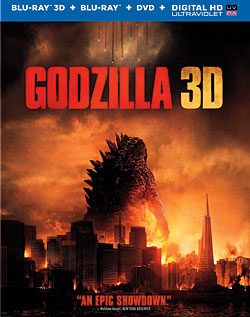Godzilla

Nearly 50 years later, a bizarre discovery is made at a mining camp in the Philippines that brings a Japanese researcher (Ken Watanabe) and his team to investigate some mysterious giant cocoons in a newly found cavern. What’s even more puzzling is it looks like one of these cocoons has recently hatched and that a large creature has escaped from the island and has hidden in the Pacific. Could this be Nature’s response?
Expectations on reboots of familiar stories are generally pretty low, but I have to give screenwriter Max Borenstein props for creating a compelling foundation for Godzilla. The first act really draws you in to set the narrative for the story, but unfortunately things start to fall apart in the second act. The central character—besides Godzilla—isn’t developed very well, and his only purpose is to somehow be involved with Godzilla’s trek eastward across the Pacific. Many have com- plained about how much screen time the monster gets, but I actually found it refreshing and somewhat Hithcock-esque in that director Gareth Edwards shows the lead-up and aftermath of most of the attacks and allows the viewer to fill in the blanks.
 The film was shot natively in 2D and converted to 3D in post-production. Frankly, the 3D doesn’t add much to the experience and in some ways detracts, especially in the really dark scenes where shadows are less resolved versus the 2D. Still, the CGI effects have more 3D pop than the non-green-screen scenes. Of the two versions, I much preferred the 2D mainly due to increased brightness, deeper—and uncrushed—black levels, and less strain on my nose from the heavy glasses needed for 3D on my JVC projector.
The film was shot natively in 2D and converted to 3D in post-production. Frankly, the 3D doesn’t add much to the experience and in some ways detracts, especially in the really dark scenes where shadows are less resolved versus the 2D. Still, the CGI effects have more 3D pop than the non-green-screen scenes. Of the two versions, I much preferred the 2D mainly due to increased brightness, deeper—and uncrushed—black levels, and less strain on my nose from the heavy glasses needed for 3D on my JVC projector.
The DTS-HD Master Audio 7.1 track is the true star of the show and is one of the best soundtracks of the year, if not the entire Blu-ray format. Every element is here—active pans, clear dialogue, and bass response that will wake the dead. There are numerous cases of electromagnetic explosions that encompass the room, and when Godzilla is on the attack, the entire neighborhood will know something is amiss. The utilization of the rear speakers shines during the battles but isn’t forgotten in the subtler scenes and provides lifelike ambience. Dialogue can sometimes get lost in such a bombastic presentation, but that’s not the case here. It remains intelligible throughout and firmly rooted in the center speaker.
Supplements include three interesting vignettes relating to what transpires during the movie as well as four behind-the-scenes featurettes that delve into the production.
This may be the best big-screen Godzilla we’ve ever seen, but frankly, the bar is set pretty low, especially after the 1998 stinker from Roland Emmerich. I found the ending a bit of a letdown, but the audio track is well worth the price of admission alone, and I was pleased there was some semblance of a story to enjoy.
Blu-Ray 3D
Studio: Warner Bros., 2014
Aspect Ratio: 2.40:1
Audio Format: DTS-HD Master Audio 7.1
Length: 123 mins.
MPAA Rating: PG-13
Director: Gareth Edwards
Starring: Aaron Taylor-Johnson, Ken Watanabe, Bryan Cranston










































